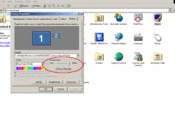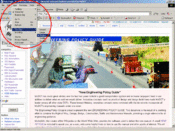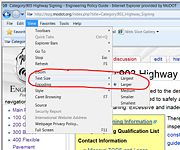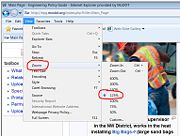Help Article: Difference between revisions
m →Division Contacts: Per MT, updated EPG contact |
|||
| Line 205: | Line 205: | ||
:::Right of Way: | :::Right of Way: | ||
::'''''Maintenance:''''' | ::'''''Maintenance:''''' Tim Jackson | ||
::'''''Motor Carrier:''''' Jan Skouby | ::'''''Motor Carrier:''''' Jan Skouby | ||
Revision as of 10:43, 4 June 2012
| Helpful EPG Videos |
| Logging into the EPG |
| Finding Info in the EPG |
| Article History & How to Receive EMails When Articles are Revised |
The Engineering Policy Guide (EPG) contains MoDOT policy, procedure and guidance for the planning, design, construction and maintenance of roadway and related facilities. It also includes specific technical topics of right of way, bridge, traffic and materials. The information is presented in numerous articles having as simple a layout as possible. These articles are numbered to reflect as closely as possible the pay items and divisions from the spec book, Missouri Standard Specifications for Highway Construction.
| EPG articles are not referenced as "sections" but as EPG XXX.X or "articles" to avoid confusion with MoDOT specs. |
The EPG is not a contract document and EPG articles are referenced as EPG XXX.X or "articles" - not "sections" - to avoid confusion with MoDOT specs. Where a conflict exists between the EPG and a contract, the contract document rules. References and links to the Missouri Standard Specifications are given as "Sec XXX.XX" or "Section XXX.XX of the Standard Specifications." References and links to the Missouri Standard Plans for Highway Construction are "Standard Plan XXX.XX".
Organization
Articles are grouped into the spec book’s divisions (for example, the EPG articles in EPG 100 General mirror Division 100 specs, articles in EPG 300 Bases mirror Division 300 specs, etc.). Many articles have been subdivided into additional articles. For example, the reader may notice that EPG 903.6 Warning Signs and other EPG 903 articles are listed at the bottom of EPG 903 Highway Signing.
In most articles the reader will notice numerous words in blue. These words are links to another article, figure or website with related information. This allows the reader to effectively navigate.
While every effort has been made to base the article numbers on MoDOT pay items and specs, not all articles in the EPG are reflected in the pay items and specs. For example, many EPG “100 General” articles are important to the design and construction of roadway facilities but do not directly correspond to specific pay items. Some of these are:
Similar examples are to be found in the EPG 200, EPG 300, etc. articles.
Searching the EPG
Google. Although this document has been organized in a logical manner (at least to the writers), it does contain a huge amount of information that can make finding a specific idea difficult. Therefore, a Google search engine is available on the left near the top of every article. It functions in the same manner as a conventional search engine on the worldwide web and is very effective!
Find (on This Page). Once the reader has used the Google search engine to arrive at an article, it may still be difficult to find the reference’s exact location since some EPG articles are large. In the upper left of each EPG article, next to “File”, we recommend the reader click “Edit”, then, in the drop-down menu, “Find (on This Page)” and type in the desired key word(s). The hot key for "Find (on This Page)" is "Ctrl-F". If the entry is in the article, it will be highlighted.
How best to view the articles
The articles are best viewed on your computer monitor with the following settings:
Use of Terms in the EPG
- May is for optional practice(s) with no requirement or recommendation.
- Shall and Will indicate mandatory practice. Contract documents often contain independent definitions.
- Should indicates something is expected or typically necessary. The action is not absolutely mandatory but deviation from this practice calls for engineering documentation.
EPG Approval Process
| Just copy and paste the affected portion of your division's EPG article into a Word file. Place the Word file into revision mode and make your proposed changes to the file. |
| Then email the Word file, along with any other necessary information (such as the fiscal impact, why your division wants the change, etc.) to the Engineering Policy Group. |
| If your division’s info is already in the EPG, do not email Word files of revisions to your division’s old manual. Base your division's proposed revisions on EPG text, not the old manuals. |
| Along with the actual proposed textual revision of the EPG, provide: |
| 1) Any other standard affected by the revision, |
| 2) The name of the proposal's sponsor, |
| 3) The proposal's summary and |
| 4) The proposal's fiscal impact. |
Revisions are provided to the Chief Engineer and the Senior Management Team on a bimonthly schedule via electronic ballot. Each District Engineer and Division Engineer has the opportunity to comment on revisions to their respective Director. The Program Delivery and System Management Directors submit the final decision on Level 2 revisions to the Engineering Policy Administrator.
Proposed EPG revisions can also be submitted to the Engineering Policy Group from a division. The proposal must reflect information approved by the division head. Proposed revisions will be submitted for approval.
Every submittal must also document, along with the actual proposed textual revision to the EPG:
- 1) Any other standard affected by the revision. Provide electronic files of all the revisions to other MoDOT standards (Standard Plans, specs, JSPs, etc.) impacted by the proposal. Word files in revision mode are required for textual changes. Dgn files are preferred for Standard Plan revisions although a redlined hard copy showing the proposed changes is also acceptable.
- 2) Sponsor. The name of the sponsor from within the division proposing the revision is required. The sponsor is the person most knowledgeable or central to the proposal.
- 3) Summary. Provide the reason why the idea should be carried out (why it is necessary or its benefit). This justification may be critical in the decision to approve the proposal or not.
- 4) Fiscal Impact. Provide a dollar estimate for the proposal’s costs or savings to MoDOT. Include whatever calculations (initial savings or life cycle savings, for example) or assertions are necessary to accurately convey the proposal’s financial impact. The fiscal impact must be a numeric dollar value, not simply a vague financial discussion.
Proposed revisions will be categorized by the Engineering Policy Administrator based on the following guidelines:
Level 1 Approval. If the idea is a routine technical matter, an errata correction or a clarification, it can be approved by the Engineering Policy Administrator without comment from the district engineers, the division engineers or the Chief Engineer. The EPG will be revised as necessary.
Level 2 Approval. If the idea is a moderate technical change, if it requires specific expertise (e.g. structural design, etc.) or if it impacts more than one division then it will be reviewed by the district and division engineers. They will provide their comments to the appropriate Director(s) who will consider the idea before providing their decision to the Engineering Policy Administrator. The Federal Highway Administration will also be given 20 working days to provide comment to the Engineering Policy Administrator. The EPG will be revised as necessary.
Level 3 Approval. If the idea is a complex technical change, contentious, has high cost or impacts MoDOT's external conduct of business it goes directly to the Chief Engineer after initial review and comment. The EPG will be revised to reflect the Chief Engineer's decision. The Federal Highway Administration requires 20 working days to provide comment to the Engineering Policy Administrator on any proposed EPG revision.
In order to speed the approval process, district and division engineers should have at least one alternate team member with full authority to act when they are absent. This will avoid the districts' and divisions' forfeiting their right to comment.
| Tips on Text |
| While the Engineering Policy Group edits all submittals, a few grammatical guidelines for the EPG include: |
| Assure/Ensure/Insure: The word “assure” is a personal guarantee based on reputation. “Ensure” is used when the party is to make certain of something or to be careful. “Insure” refers to actions protected by insurance, and indicates that money is involved. |
| Dimensions: Typically use “high”, “wide” and “long” instead of “in height”, “in width” and “in length”. |
| Farther/Further: Use “farther” to express a physical distance, such as 10 miles farther, and “further” for a non-physical dimension, such as further thought. |
| Fewer/less: Use “few” or “fewer” for something comprised of a small number of countable components (such as fewer dollars, fewer gallons of water, etc.). Use “less” for amounts that are not being counted (less money, less water, etc.). |
| Gage/Gauge: Gage is the size or thickness. Gauge is the instrument for measuring. |
| Gender: Minimize the use of “he/she”, “he and she” and “she or he”. |
| High/Tall: Use “high” to express a lofty position, such as the clouds are high. Use “tall” to express a great vertical dimension, such as the tall post. |
| Also refer to Use of Terms in the EPG, above. |
Once a substantive Level 2 or 3 revision is approved, a notice (with effective date if required) will be posted on the EPG Main Page under the heading “Recent Changes”.
The Engineering Policy Group also receives proposed EPG corrections or improvements from districts, although most significant technical revisions would normally go through the divisions. We will gladly receive emails with your specific correction.
Style Guide for Proposed EPG Revisions
When a division proposes a revision to the Engineering Policy Guide (EPG), what should be submitted to the Engineering Policy Group?
The division should usually begin by referencing the current contents of the EPG article to be revised. Submit a Word document in revision mode showing both proposed additions and deletions to the EPG article. The proposed revision should use complete sentences and paragraphs as much as possible. Bullets are permissible, but they are typically used sparingly.
If changes are proposed to EPG figures, provide the new .jpg files for photos and .pdf or MicroSoft Word documents for the textual figures. The EPG wiki can accommodate a number of other types of files, but .jpg, .pdf and .doc files tend to be most efficient.
Logging into the EPG

Just viewing the EPG, without logging into it, opens the single reference for all MoDOT engineering and engineering-related guidance. But logging into the EPG permits the reader access to a number of capabilities including viewing the history of an article, leaving comments on a discussion page, tracking revisions through "my watchlist", accessing a printable version of an EPG article and viewing the "what links here" (that shows all the other articles linked to the chosen article).

To log in to the EPG, MoDOT employees simply click the "Log in" (located at the top of any EPG article). The "Username" required by the EPG is the same as the username entered when logging into a MoDOT computer. The "password" required by the EPG is also the same as your computer password. Yes, every time your computer's password changes, so will your EPG password.
Benefits of Logging into the EPG
Your engineering and engineering-related information is already incorporated into the EPG, but logging into the EPG will make this information handier and more useful.
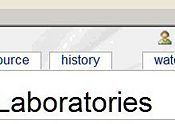
History
Would it be useful for you to be able to find when and how an article that you are interested in changed? Or view exactly what an EPG article stated and how it looked in the past? Log into the EPG and a “History” tab is available at the top of every article, providing a view of any previous versions of the EPG article or comparing any two versions of the article on a line-by-line basis.
Many of the revisions will have a brief explanation. A bold “m” indicates a minor change (either a Level 1 Approval or editorial change).

Watch and My Watchlist
Would you find it useful to easily gather the articles in which you are interested and also be able to view the changes to these articles?
Log into the EPG and a “watch” tab is located at the top of every article in the EPG. By simply clicking the “watch” tab (and causing it to become “unwatch”), the article is added to your watchlist (those articles of which you want to keep track).
How are the revisions to your watchlist articles viewed? At any time you may open “my watchlist”, located above the EPG article’s tabs, and choose whether you want to view the changes to your selected articles that occurred during the past hour, 2 hours, 6 hours, 12 hours, day, 3 days, 7 days or all the changes that have occurred. Minor changes to a “My watchlist” article are identified with a bolded “m”. New articles are identified with an “N”. A brief description is provided for notable revisions.
My Preferences
Would you find it useful to have an email inform you every time an EPG article of interest to you has been changed?
This email would not provide the details of the revision, but that the article was revised in some manner. Log in to the EPG and you will be able to check the article’s history to view the actual revision.

To obtain an email alert every time an EPG article of interest has been revised, click “My Preferences”, located above the EPG article’s tabs. This leads to a “User Profile” tab. Near the bottom of the “User Profile” is the “E-mail” portion in which you may choose the various revision situations to send you an email.
Discussions and Suggestions
Those logged into the EPG are encouraged to use the discussion capability of the EPG. If you have a question, it is likely others may, too. Any suggestions you have may also be very helpful to another reader, as well. Use the “Discussion” capabilities of the EPG to contribute questions and suggestions for all other readers. The Engineering Policy staff monitors all articles so that your comment can be addressed.

After logging in, simply go to the article of concern and select the “Discussion” tab at the top of the article. If your comment or question is the first discussion for the article, you will be shown an edit screen. Type in your comment or question. Otherwise, an existing discussion will be shown. Additional comments can be added by selecting the “+” tab.
Division Contacts
Since the divisions provide authoritative input, consulting with their liaisons or contacts may provide the help you require or receive your input. Below is a listing of divisional personnel with whom the Engineering Policy staff works and who may be helpful to you:
- Bridge: Greg Sanders
- Chief Counsel's Office:
- Construction and Materials
- Chemical Laboratory: Todd Bennett, Leonard Vader
- Construction Engineering: Jeremy Kampeter
- Geotechnical Engineering: Mike Fritz
- Materials:
- Physical Laboratory: Victoria Woods
- Design:
- Environmental & Historic Preservation: Mike Meinkoth
- Right of Way:
- Maintenance: Tim Jackson
- Motor Carrier: Jan Skouby
- Multimodal: Michelle Teel
- Planning: Renate Wilkinson, Jenni Jones, Machelle Watkins
- Traffic: Julie Stotlemeyer
